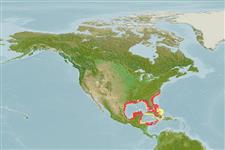Common names from other countries
Environment: milieu / climate zone / depth range / distribution range
Ecologia
marinhas demersal. Subtropical; 35°N - 15°N, 98°W - 74°W
Western Atlantic: Florida (USA), Little Bahama Bank (Bahamas) and the entire Gulf of Mexico to Campeche, Mexico (Ref. 7251). Range extended to Brazil (Ref. 94035).
Length at first maturity / Tamanho / Peso / Idade
Maturity: Lm 7.6, range 10 - ? cm
Max length : 33.0 cm TL macho/indeterminado; (Ref. 85752)
Descrição breve
Morfologia | Morfometria
Dark brown bars on caudal and pectoral fins; bars on pectoral fin irregularly joined (Ref. 26938).
Commonly found in seagrass beds and rocky cuts in coastal bays and lagoons, and in shallows along open coast. In western coast of Florida, adults spawn in February and March (Ref. 26938). Nesting males produce grunt calls called the boatwhistle as advertisement of competition among males and to attract females (Ref. 45338). Neither opercular nor dorsal gland is venomous (Ref. 57406).
Life cycle and mating behavior
Maturidade | Reprodução | Desova | Ovos | Fecundidade | Larvas
Robins, C.R. and G.C. Ray, 1986. A field guide to Atlantic coast fishes of North America. Houghton Mifflin Company, Boston, U.S.A. 354 p. (Ref. 7251)
Categoria na Lista Vermelha da IUCN (Ref. 130435)
CITES (Ref. 128078)
Not Evaluated
Ameaça para o homem
Reports of ciguatera poisoning (Ref. 31174)
Utilização humana
Mais informação
ReferênciasAquaculturaPerfil para aquaculturaEstirpesGenéticaElectrophoresesHereditariedadeDoençasProcessamentoMass conversion
Ferramentas
Relatórios especiais
Descarregue XML
Fontes da internet
Estimates based on models
Preferred temperature (Ref.
115969): 23.3 - 27.9, mean 24.6 (based on 316 cells).
Phylogenetic diversity index (Ref.
82804): PD
50 = 0.5312 [Uniqueness, from 0.5 = low to 2.0 = high].
Bayesian length-weight: a=0.01288 (0.00798 - 0.02079), b=3.06 (2.92 - 3.20), in cm Total Length, based on LWR estimates for this species & (Sub)family-body (Ref.
93245).
Nível Trófico (Ref.
69278): 3.7 ±0.6 se; based on size and trophs of closest relatives
Resiliência (Ref.
120179): Médio, tempo mínimo de duplicação da população 1,4 - 4,4 anos (K=0.218; tm=1+).
Fishing Vulnerability (Ref.
59153): Moderate vulnerability (38 of 100).
